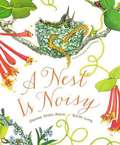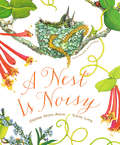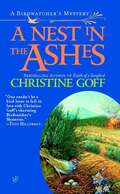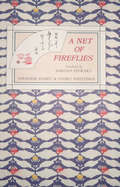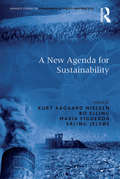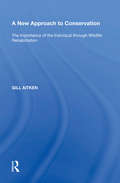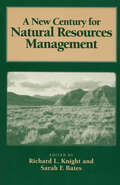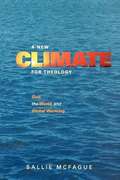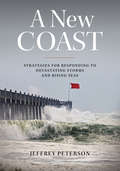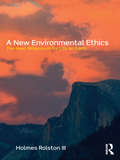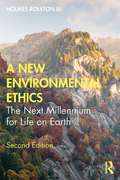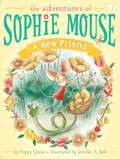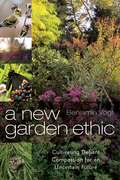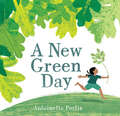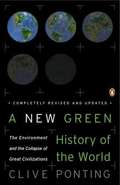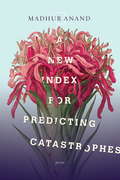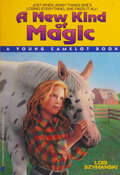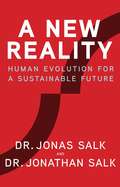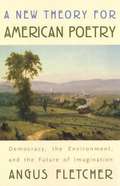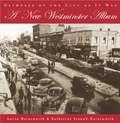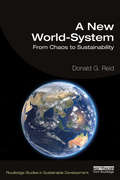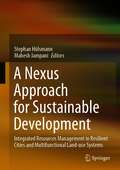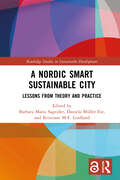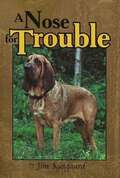- Table View
- List View
A Nest Is Noisy
by Dianna Hutts Aston LongFrom the award-winning creators of An Egg Is Quiet, A Seed Is Sleepy, A Butterfly Is Patient, and A Rock Is Lively comes this gorgeous and informative look at the fascinating world of nests. From tiny bee hummingbird nests to orangutan nests high in the rainforest canopy, an incredible variety of nests are showcased here in all their splendor. Poetic in voice and elegant in design, this carefully researched book introduces children to a captivating array of nest facts and will spark the imaginations of children whether in a classroom reading circle or on a parent's lap.
A Nest Is Noisy
by Dianna Hutts AstonFrom the award-winning creators of An Egg Is Quiet, A Seed Is Sleepy, A Butterfly Is Patient, and A Rock Is Lively comes this gorgeous and informative look at the fascinating world of nests. From tiny bee hummingbird nests to orangutan nests high in the rainforest canopy, an incredible variety of nests are showcased here in all their splendor. Poetic in voice and elegant in design, this carefully researched book introduces children to a captivating array of nest facts and will spark the imaginations of children whether in a classroom reading circle or on a parent's lap. Plus, this is a fixed-format version of the book, which looks nearly identical to the print version.
A Nest in the Ashes (Birdwatcher's Mystery #3)
by Christine GoffIn her first two novels—A Rant of Ravens and Death of a Songbird—Christine Goff offered a bird’s eye view of murder in the National Park wilds of Colorado. Now, in her latest birdwatcher's mystery, she reveals that there are more things lurking in the trees than birds of prey... National Park Service ranger Eric Linenger has been asked to oversee a "prescribed burn” of 1,000 acres of Rocky Mountain National Park. Although he knows the controlled fire is a necessity, it threatens the habitat of Green-Tailed Towhees and Virginia Warblers. His friends at EPOCH are strongly opposed, but it’s Eric’s job. Once lit, the flames quickly spread beyond the intended acreage—destroying a real estate development before finally being extinguished. The body of Eric's boss, Wayne Devlin, is found near the origin of the blaze—and it appears as if he deliberately intended the fire to rage out of control. As Eric investigates, he discovers that many people had reasons for ensuring the burn went all to blazes—including some of his friends...
A Net of Fireflies
by Harold StewartA Net of Fireflies is a Collection of Japanese Haiku and Haiku paintings.
A Net of Fireflies
by Harold StewartA Net of Fireflies is a Collection of Japanese Haiku and Haiku paintings.
A New Agenda for Sustainability (Routledge Studies in Environmental Policy and Practice)
by Bo Elling Erling JelsøeTwo decades after the Brundtland Commission's Report "Our Common Future" adopted the concept of 'sustainable development', this book provides a renewal of the concept exploring the potential for new practices and fields for those involved in sustainability activity. The book addresses a number of themes concerning firstly, the provision of a "next generation perspective", which was a central, and still unresolved, notion of the original Brundtland definition and, secondly the provision of new milestones for policy and research that can expand the discussion on this second generation concept on sustainability. The material dealt with in the book offers a wide variety of perspectives on sustainability and reflects the importance of interdisciplinary and transdiciplinary work in the field. Suggesting targets for future analytical and political efforts in achieving global sustainability, this book offers new analytical opportunities for holistic politics and research at a general and sector level.
A New Approach to Conservation: The Importance of the Individual through Wildlife Rehabilitation (Ashgate Studies In Environmental Policy And Practice Ser.)
by Gill AitkenConservationists assume a set of underlying values which guide their decision-making and action. The safeguarding or promotion of biodiversity, it is believed, is the means by which nature is best protected. This book examines - and challenges - these general conservation assumptions. While reinforcing the need to halt extinction and value biodiversity, it shows that biodiversity needs to be more clearly understood, perhaps being replaced by the notion of 'wildness'. It examines how biodiversity is a holistic term, and how individual species need to be assessed and their own contribution to 'wildness' has to be recognized. The book proposes a new way of conservation - one which makes more room for neglected, rather than endangered or rare species. It also asserts that 'wildness' is not incompatible with certain kinds of human intervention.
A New Century for Natural Resources Management
by Robert Costanza Sarah F. Bates Vawter Parker Richard L. Knight Steward Pickett Peter BerckThis book explores the changes that are leading to a new century of natural resources management. It places the current situation in historical perspective, analyzes the forces that are propelling change, and describes and examines the specific changes in goals, policy, and practice that are transforming all aspects of natural resources management.The book is an important overview for wildlife biologists, foresters, and others working for public land agencies; professors and students of natural resources; and all those whose livelihood depends on the use of public natural resources.
A New Climate For Theology: God, The World, And Global Warming
by Sallie McFagueClimate change promises monumental changes to human and other planetary life in the next generations. Yet government, business, and individuals have been largely in denial of the possibility that global warming may put our species on the road to extinction. Further, says Sallie McFague, we have failed to see the real root of our behavioral troubles in an economic model that actually reflects distorted religious views of the person. At its heart, she maintains, global warming occurs because we lack an appropriate understanding of ourselves as inextricably bound to the planet and its systems. A New Climate for Theology not only traces the distorted notion of unlimited desire that fuels our market system; it also paints an alternative idea of what being human means and what a just and sustainable economy might mean. Convincing, specific, and wise, McFague argues for an alternative economic order and for our relational identity as part of an unfolding universe that expresses divine love and human freedom. It is a view that can inspire real change, an altered lifestyle, and a form of Christian discipleship and desire appropriate to who we really are. Table of Contents Preface Part One: The Science and its Significance for Theology Chapter 1: Climate Change: The Evidence and Consequences Chapter 2: Global Warming: A Theological Problem Part Two: Exploring God and the World within Climate Change Chapter 3: Who Are We? Ecological Anthropology Chapter 4: Who Is God? Creation and Providence Chapter 5: How Shall We Live? Christianity and Planetary Economics Part Three: Serving God and City Living within Climate Change Chapter 6: Why We Worship: Praise and Compassion as Intimations of Transcendence Chapter 7: Where We Live: Urban Ecotheology Part Four: Despair and Hope within Climate Change Chapter 8: Is a Different World Possible? Human Dignity and the Integrity of Creation in a Time of Global Warming Chapter 9: ?The Dearest Freshness Deep Down Things: The Holy Spirit and Climate Change Notes
A New Coast: Strategies for Responding to Devastating Storms and Rising Seas
by Jeffrey PetersonMore severe storms and rising seas will inexorably push the American coastline inland with profound impact on communities, infrastructure, and natural systems. In A New Coast, Jeffrey Peterson draws a comprehensive picture of how storms and rising seas will change the coast. Peterson offers a clear-eyed assessment of how governments can work with the private sector and citizens to be better prepared for the coming coastal inundation.Drawing on four decades of experience at the Environmental Protection Agency and the United States Senate, Peterson presents the science behind predictions for coastal impacts. He explains how current policies fall short of what is needed to effectively prepare for these changes and how the Trump Administration has significantly weakened these efforts. While describing how and why the current policies exist, he builds a strong case for a bold, new approach, tackling difficult topics including: how to revise flood insurance and disaster assistance programs; when to step back from the coast rather than build protection structures; how to steer new development away from at-risk areas; and how to finance the transition to a new coast. Key challenges, including how to protect critical infrastructure, ecosystems, and disadvantaged populations, are examined. Ultimately, Peterson offers hope in the form of a framework of new national policies and programs to support local and state governments. He calls for engagement from the private sector and local and national leaders in a "campaign for a new coast.”A New Coast is a compelling assessment of the dramatic changes that are coming to America's coast. Peterson offers insights and strategies for policymakers, planners, and business leaders preparing for the intensifying impacts of climate change along the coast.
A New Environmental Ethics: The Next Millennium for Life on Earth
by Holmes Rolston IIINo one looking ahead at the middle of the last century could have foreseen the extent and the importance of the ensuing environmental crises. Now, more than a decade into the next century, no one can ignore it. A New Environmental Ethics: the Next Millennium for Life on Earth offers clear, powerful, and oftentimes moving thoughts from one of the first and most respected philosophers to write on the environment. Rolston, an early and leading pioneer in studying the moral relationship between humans and the earth, surveys the full spectrum of approaches in the field of environmental ethics. This book, however, is not simply a judicious overview. Instead, it offers critical assessments of contemporary academic accounts and draws on a lifetime of research and experience to suggest an outlook for the future. As a result, this focused, forward-looking analysis will be a necessary complement to any balanced textbook or anthology in environmental ethics, and will teach its readers to be responsible global citizens, and residents of their landscape, helping ensure that the future we have will be the one we wish for.
A New Environmental Ethics: The Next Millennium for Life on Earth
by Holmes Rolston IIIThis Second Edition of A New Environmental Ethics: The Next Millennium for Life on Earth offers clear, powerful, and often moving thoughts from Holmes Rolston III, one of the first and most respected philosophers to write on the environment and often called the "father of environmental ethics." Rolston surveys the full spectrum of approaches in the field of environmental ethics and offers critical assessments of contemporary academic accounts. He draws on a lifetime of research and experience to suggest an outlook, and even hope, for the future. This forward-looking analysis, focused on the new millennium, will be a necessary complement to any balanced textbook or anthology in environmental ethics. The First Edition guaranteed "to put you in your place." Beyond that, the Second Edition asks whether you want to live a "de-natured life on a de-natured planet." Key Updates in the Second Edition Covers the worsening environmental situation due to actions of the Trump administration, including withdrawal from the Paris Agreement and from the U.N. Framework Convention on Climate Change Includes information on legislation in key U.S. states (e.g., California and New York) aimed to ameliorate the damage done at the federal level Increases coverage of group knowledge, group agreement and disagreement, and group action in collective environmental ethics, as distinguished from individual knowledge and action Examines the deleterious effects of online consumer behavior Explains how a loss of solidarity among a nation’s citizens and even a larger solidary among humanity leads to environmental degradation Offers new analysis of the effects of epistemic bubbles, echo chambers, and fake news on the behavior of voters and consumers Provides an extended critique of the Anthropocene Epoch, and the prospect of geo-engineering Earth to become a synthetic environment.
A New Friend (The Adventures of Sophie Mouse #1)
by Poppy GreenIn this first of a charming series about a little mouse and her forest friends, Sophie Mouse must convince her classmates—and herself—that a new student is nothing to fear. Even if he is a snake! Readers will delight in The Adventures of Sophie Mouse!In the first book of The Adventures of Sophie Mouse, springtime has arrived at Silverlake Forest! The animals are coming out of their homes, buds are blooming on the trees, and the air smells of honeysuckles and tree bark. Sophie Mouse can’t wait to go back to school after the long winter break. Even better, there’s a new student in class—Sophie loves meeting new animals! But the class gasps when Owen enters: he’s a snake! No one is brave enough to sit near him, or play with Owen at recess, or even talk to him. Can Sophie help her friends understand that Owen’s not scary after all? With easy-to-read language and illustrations on almost every page, the Adventures of Sophie Mouse chapter books are perfect for beginning readers.
A New Garden Ethic: Cultivating Defiant Compassion for an Uncertain Future
by Benjamin VogtIn a time of climate change and mass extinction, how we garden matters more than ever: “An outstanding and deeply passionate book.” —Marc Bekoff, author of The Emotional Lives of AnimalsPlenty of books tell home gardeners and professional landscape designers how to garden sustainably, what plants to use, and what resources to explore. Yet few examine why our urban wildlife gardens matter so much—not just for ourselves, but for the larger human and animal communities.Our landscapes push aside wildlife and in turn diminish our genetically programmed love for wildness. How can we get ourselves back into balance through gardens, to speak life's language and learn from other species?Benjamin Vogt addresses why we need a new garden ethic, and why we urgently need wildness in our daily lives—lives sequestered in buildings surrounded by monocultures of lawn and concrete that significantly harm our physical and mental health. He examines the psychological issues around climate change and mass extinction as a way to understand how we are short-circuiting our response to global crises, especially by not growing native plants in our gardens. Simply put, environmentalism is not political; it's social justice for all species marginalized today and for those facing extinction tomorrow. By thinking deeply and honestly about our built landscapes, we can create a compassionate activism that connects us more profoundly to nature and to one another.
A New Green Day
by Antoinette PortisIf you listen, nature speaks. Explore nature through evocative riddles and bold imagery that take the reader from day to night and back again in this perfect read aloud.From the author of the Sibert Honor-winning title Hey, Water! comes a book of poetic riddles that encourage young readers to explore the natural world. Who scribbles on the sidewalk with glistening ink? Snail!Who's a comma in a long, long sentence of a stream? Tadpole!On each spread, children will solve riddles about the familiar animals, plants and the weather that one child encounters outdoors throughout a whole day. Active readers will delight in the clever language and striking illustrations.A Junior Library Guild SelectionSelected for the CBC Champions of Change Showcase
A New Green History Of The World: The Environment And The Collapse Of Great Civilizations
by Clive PontingClive Ponting's original and provocative history of human civilization - now in a thoroughly revised, expanded, and updated edition. Years ahead of its time, Clive Ponting captivated readers with A Green History of the World, his study of great civilizations and the causes of their fall. Using the Roman empire as its central example, this classic work reveals how overexpansion and the exhaustion of available natural resources have played key roles in the collapse of all great cultures in human history. With an argument of urgent relevance to our modern society, A Green History of the World offers a provocative and illuminating view of human history and its relationship to the environment.
A New Index for Predicting Catastrophes
by Madhur AnandA striking poetic debut that brilliantly illuminates and celebrates the intersection of poetry and science, and the ways they can mediate our discovery of the world and our place in it. Originating from her living room, backyard garden, university office, or the field sites in boreal or tropical forests, the poems in Madhur Anand's captivating debut collection compose a lyric science; they bring order and chaos together into a unified theory of predicting catastrophes, large and small. Anand's ecologist poetics are sophisticated and original; her voice is an "index," a way of cataloguing and measuring the world and human experience, and of illuminating the interconnectedness at the heart of all things. Narrating the beauty of her perceived world, the poems unabashedly embrace the scintillant language of scientific evidence as they interrogate crises of personal and global concern. The result is a poetry that is as complex as it is compassionate. Anand's modernist intervention into "nature" poetry is a sparkling addition to poetics in Canada and beyond.From the Trade Paperback edition.
A New Kind of Magic (Charming Ponies)
by Lois SzymanskiJenny and her family have to move, and that seems to her like the worst thing in the world. Instead of living on a farm, with her horse Magic and the other animals, Jenny will live in an apartment in town where she can't keep a horse. Everything is so different that Jenny is sure she'll never be happy again. But that's because Jenny doesn't know what it's like to live in a different place... and she's in for a lot of very nice surprises.
A New Reality: Human Evolution for a Sustainable Future
by Jonas Salk Jonathan Salk David Dewane Elizabeth H BlackburnA New Reality: Human Evolution for a Sustainable Future provides a startling, fresh new message of understanding, perspective and hope for today’s tense, rapid-fire, kaleidoscopically changing world. A New Reality: Human Evolution for a Sustainable Future provides a startling, fresh new message of understanding, perspective and hope for today’s tense, rapid-fire, kaleidoscopically changing world. Drawn from the writings of visionary scientist Jonas Salk, who developed the polio vaccine, extended and developed by his son Jonathan, the message of the book explodes from the past and sheds light on tensions that besiege us and the currents of discord that are raging as these words are written. More importantly, it indicates a way forward out of our current situation. Written by a world-famous doctor and folk hero, based on population data, rich in visual imagery, elegantly designed, and clearly written, A New Reality is unique in the marketplace. Readable in one or two sittings, it is accessible to the general reader while at the same time being of essential value to policy makers and academics. Its brevity and simplicity of design belie the importance and sophistication of its message. “We are at a point in the course of human social evolution when the demands of survival converge with the higher ideals of humankind and the well-being and flourishing of human society. It is up to us to see that we navigate this transition, adapting to and emerging in a new reality.” —A New Reality Our country is divided and polarized. Terrorism is a major threat throughout much of the world. Mass migrations are causing national and international tension. Population growth continues to increase, especially in the developing regions of the world. Controversy rages as to the use of fossil fuels versus the development of alternative forms of energy. Disagreement continues about climate change. Opposing currents of opinion collide as to how much we should help other areas in the world and how much to help ourselves. Basic values are in conflict. More than 40 years ago, Jonas Salk understood that we are at a unique moment in the history of the human species. After centuries of increase, population growth has begun to slow and is trending toward equilibrium. This change is accompanied by an equally significant change in human values—a shift from those based on unlimited availability of resources, unremitting growth, excess, independence, competition and short-term thinking to those based on limits, equilibrium, balance, interdependence, cooperation and long-term thinking. This momentous transition is the source of far-reaching tension and conflict. The way through this difficult era is to understand its basis and to focus on new values that will be of the greatest benefit to humankind. There is an urgency, however, and failure to adapt will result in disaster both for humanity and for the planet as a whole. A New Reality delivers a message of both caution and hope. Readers across the social and political spectrum will find it a reasoned and balanced counterpoint to current social and political trends. Its elegant design and long-range perspective will appeal to general readers, policy makers, millennials, baby boomers, teachers, and students, filling a need in the marketplace for a work of positivity and wisdom in otherwise bleak times.
A New Theory for American Poetry: Democracy, the Environment, and the Future of Imagination
by Angus FletcherAmid gloomy forecasts of the decline of the humanities and the death of poetry, Angus Fletcher, a wise and dedicated literary voice, sounds a note of powerful, tempered optimism. He lays out a fresh approach to American poetry at large, the first in several decades, expounding a defense of the art that will resonate well into the new century. Breaking with the tired habit of treating American poets as the happy or rebellious children of European romanticism, Fletcher uncovers a distinct lineage for American poetry. His point of departure is the fascinating English writer, John Clare; he then centers on the radically American vision expressed by Emerson and Walt Whitman. With Whitman this book insists that "the whole theory and nature of poetry" needs inspiration from science if it is to achieve a truly democratic vista. Drawing variously on Complexity Theory and on fundamentals of art and grammar, Fletcher argues that our finest poetry is nature-based, environmentally shaped, and descriptive in aim, enabling poets like John Ashbery and other contemporaries to discover a mysterious pragmatism. Intense, resonant, and deeply literary, this account of an American poetics shows how today's consumerist and conformist culture subverts the imagination of a free people. While centering on American vision, the argument extends our horizon, striking a blow against all economically sanctioned attacks upon the finer, stronger human capacities. Poetry, the author maintains, is central to any coherent vision of life.
A New Westminster Album: Glimpses of the City As It Was
by Gavin Hainsworth Katherine Freund-HainsworthFrom prospectors to politicians, promoters to profiteers, New Westminster’s known them all. It is Western Canada’s oldest city, aptly named by Queen Victoria as the first capital of the new colony of British Columbia. On the mighty Fraser River, it has survived gold rushes, loss of capital status, fire, flood, the Depression, and two world wars. This collection of illuminating black and white photographs, artwork, and text shows how its tenacious citizens have thrived. It follows the city’s festivals, traditions, organizations, people, and neighbourhoods. The city has both witnessed and been the centre of the fascinating events that shaped B.C. This multifaceted photographic history album depicts almost 150 years of the City of New Westminster.
A New World-System: From Chaos to Sustainability (Routledge Studies in Sustainable Development)
by Donald G. ReidA New World-System: From Chaos to Sustainability examines the present crisis in the social and ecological environment that is producing profound, potentially catastrophic challenges to the planet and humanity and outlines a process for moving forward to address these critical issues. This book is a cautionary interpretation of the present and vision for the future. Unlike other books on this or allied subjects that are focused singularly, Part 1 surveys the five major threats facing humanity today: climate change, inequality and poverty, new technologies, migration, and globalization. It approaches the challenge of integrating these phenomena into a global picture from a systems perspective rather than taking a purely reductionist approach to understanding what is occurring in the world today. Part 2 moves from identifying the problems to solving them, with chapters examining the ability of the present world-system to address these issues and outlining a process for action. The book concludes by discussing what could follow capitalism as a social organizing strategy and, perhaps more importantly, the consequences to the planet if we do not construct a new world-system. This book is essential reading for students and scholars of sustainable development, climate change, environmental studies, rural and urban planning, environmental psychology, political economy, sociology, social policy, leisure studies, and environmental politics. More broadly, it is a vital resource for all those interested in building a sustainable society.
A Nexus Approach for Sustainable Development: Integrated Resources Management in Resilient Cities and Multifunctional Land-use Systems
by Stephan Hülsmann Mahesh JampaniThis book explores how integrated management of environmental resources via a nexus approach can help in achieving the respective Sustainable Development Goals (SDGs). It provides conceptual considerations but mainly practical examples on how to implement a nexus approach in cities and multifunctional land-use systems to increase resource use efficiency and develop a low carbon economy. After sketching out the background and conceptual outline, contributions to the book explore key aspects of the nexus implementation. Specifically, they • Demonstrate how to sustainably use organic waste and wastewater for agriculture, • Explore examples on how to manage multifunctional land-use systems including multipurpose reservoirs, • Highlight the importance of economic incentives for successful nexus implementation, and • Provide a comprehensive perspective on challenges and opportunities of implementation, considering peer-to-peer learning, indigenous knowledge, and stakeholder participation. The chapters in this book shed a new light on key aspects of the interrelation between SDGs and the nexus approach in resilient cities and multifunctional land-use systems, and provide specific examples on how to advance sustainable resources management.
A Nordic Smart Sustainable City: Lessons from Theory and Practice (Routledge Studies in Sustainable Development)
by Barbara Maria SageidetThis book critically explores research and development on the smart sustainable city, emphasizing the tension and association between smartness and sustainability, both as a concept and as a phenomenon in a Nordic context.Worldwide, increasing urbanization and its related challenges, along with urgent environmental issues, have sped up the international interest for smart, sustainable cities as a concept that could increase the efficiency of services, minimize environmental impacts, and improve the quality of living in cities and urban areas. This book scientifically discusses the provenance, substance, and processes of the smart sustainable city, with illustrative examples of how it is translated into urban realities in a medium-sized city, drawing upon Stavanger, one of the first, and one of the leading smart sustainable cities in Europe. The book’s multidisciplinary perspectives and thematic lenses include education and knowledge, arts and culture, safety, climate and sustainability, mobility and transport, economics, democracy, participation, innovation and entrepreneurship, data, and communication. While demonstrating the academic breadth and wide-ranging impact of the smart sustainable city concept, the book promotes and updates the ground for mutual understanding, communication, and collaboration between multiple disciplines and stakeholders involved in developing functional, democratic, and sustainable solutions for the urban present and future.A Nordic Smart Sustainable City: Lessons from Theory and Practice presents an overview of scientific and practical current approaches in a readable format for practitioners and administrators in municipalities and related businesses, for researchers, academics, educators, students, and stakeholders.
A Nose For Trouble
by Jim KjelgaardThe big tawny dog named Smoky refused to hunt with the pack, so old Bill Tolliver gave the ‘no-good hound’ to Tom Rainse, the new Game Warden. Tom discovered that Smoky’s keen bloodhound nose tracked men, not animals, and soon he was hot on the trail of a ring of poachers whose mysterious leader was called ‘Black Elk.’ These illegal hunters swore they’d kill anyone who got in their way, and now Warden Tom had a special partner who could smell trouble coming. Would this tough mountain man and his fighting hound be able to stop the dangerous Black Elk gang? Or would the gentle elk, deer, and beaver disappear forever from this beautiful wild land?
